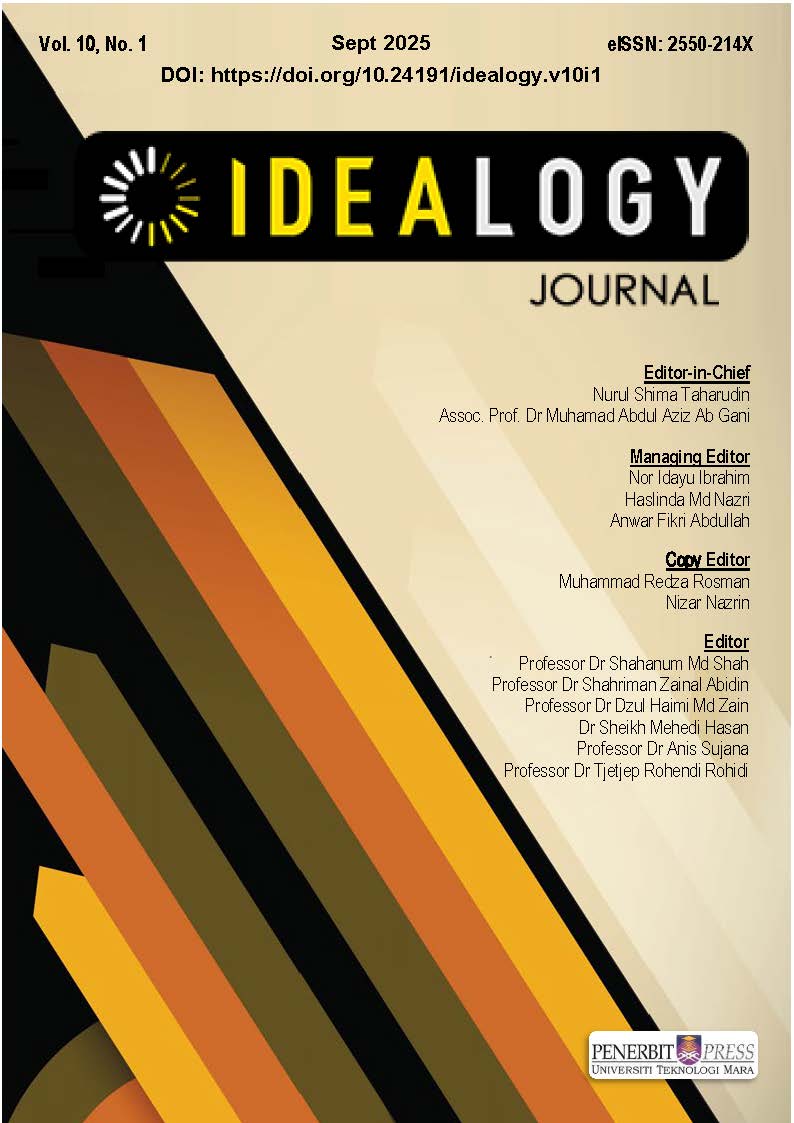The Aesthetic of Ruins in Dunhuang Murals
DOI:
https://doi.org/10.24191/idealogy.v10i1.708Keywords:
Aesthetic of Ruins, Dunhuang Mural, Texture, Material.Abstract
The Mogao Caves in Dunhuang are the world's largest and richest extant Buddhist art site, with relics from thousands of years of overlapping and merging civilizations. Dunhuang murals are a fading, disappearing work of art. This paper analyzes the aesthetic characteristics of Dunhuang murals from four aspects: composition, style, lines, and colors. The reasons for the formation of the Dunhuang mural texture are analyzed through the mottled outlines and faded traces on Dunhuang murals. The erosion of this ancient artwork by nature and humans has produced a delicate beauty similar to the beauty of ruins. This special aesthetic quality has been discussed by Ginsberg (2004), that is, gradual erosion produces new unity and artistic form. The passage of time has endowed Dunhuang murals with three characteristics: the beauty of traces, the beauty of harmony, and the beauty of mistiness. These qualities are also symbols and metaphors for the state of impermanence. The author explores the aesthetic qualities of the texture of Dunhuang murals, especially the peeling and discoloration.
Keywords: Aesthetic of Ruins1, Dunhuang Mural2, Texture3, Material4.
References
Ginsberg, R. (2004). The Ruin as Aesthetic Experience. In The Aesthetics of Ruins, pp. 155-172. Brill.
Goldstein, L. (1977) Ruins and empire: the evolution of a theme in Augustan and Romantic literature. University of Pittsburgh Pre.
Hetzler, F. M. (1982). The aesthetics of ruins: a new category of being. Journal of Aesthetic Education 16, no. 2 (1982): 105-108.
Ji, N. J. (2020). Aesthetic variation of the peeling phenomenon of Dunhuang murals and its expression in contemporary heavy color paintings. Master diss., Qingdao University.
Liang, P.P. (2017). Sui and Tang Dynasties Dunhuang mural language used in modern rock painting brushwork creation research. Master diss., Sichuan Normal University.
Liu, L. D. (2021). The painting language expression of ruins aesthetics. Fine Art Journal 02: 144.
Li, S. (1993). Preliminary understanding of cementing materials in Dunhuang murals. Dunhuang Research 01: 113-122.
Li, Z.X.,& Stefan, M. (1989). Influence of light and humidity on the discoloration of clay red cinnabar and lead red. Dunhuang Research 03: 85-98.
Patron, E., & Elias, J. (2024). The Conspicuous Colour Blue - ‘Lapis Lazuli’ - In the History of Art. Idealogy Journal, 9(1). doi:10.24191/idealogy.v9i1.519
Ruppert, J. H. (1982) A ruin aesthetic. Rochester Institute of Technology.
Shi, Y.C,& Zhang, J. (1997). The Dunhuang caves main diseases and precautions against them. Northwestern Seismological Journal 2:81-87.
Wu, J.R. (2003). Chromatic applying of Dunhuang murals and the cause of color changes. Dunhuang Research 81: 49-55.
Yu, A.A. (2014). On the aesthetic implication of imperfection. Journal of Hengshui University 16: 104-107.
Yu, L.L. (2013). Research on the emergence and development of murals diseases in Mogao grottoes, Dunhuang. Master diss., Beijing University of Chemical Technology.
Zhang, Y.D. (2015). The research on environment monitoring and development of mural disease in Mogao grottoes, Dunhuang. Master diss., Beijing University of Chemical Technology.
Zhang, Y.S. (2017). The application of pattern, color, and texture of Dunhuang murals in creation is briefly discussed. Fine Art world Journal 8: 84.
Zucker, P. (1968) Fascination of Decay: Ruins, Relic, Symbol. Ornament, The Gregg Press.
Downloads
Published
Issue
Section
License
Copyright (c) 2025 Idealogy Journal

This work is licensed under a Creative Commons Attribution-NonCommercial-NoDerivatives 4.0 International License.
UiTM Press (the Publisher) has agreed to publish the undersigned author’s paper in Idealogy Journal. The agreement is contingent upon the fulfilment of a number of requirements listed below.
1. The undersigned author warrants that the paper entitled below is original, that it is not in any way libellous or unlawful in Malaysia, that it does not infringe any copyright or other proprietary right. The undersigned hereby represents and warrants that he/she is the author of the paper, except for material that is clearly identified as to its original source, with permission notices from the copyright owners where required. The undersigned represents that he/she has the power and authority to sign and execute this agreement.
2. The undersigned author warrants that the paper entitled below has not been published elsewhere, and also it will not be submitted anywhere else for publication prior to acceptance/rejection by this Journal.
3. By submitting the paper entitled below, the undersigned author agrees to transfer the rights to publish and distribute the paper in an international e-journal (entitled above) to Publisher.
4. The undersigned author agrees to make a reasonable effort to conform to Publisher's submission guidelines and to liaise with the editor to ensure that the requirements of these guidelines are met to a reasonable degree.
5. The corresponding author signs for and accepts responsibility for releasing this material on behalf of any and all coauthors. This agreement is to be signed by at least one of the authors who has obtained the assent of the co-author(s) where applicable. After submission of this agreement signed by the corresponding author, changes of authorship or in the order of the authors listed will not be accepted.


